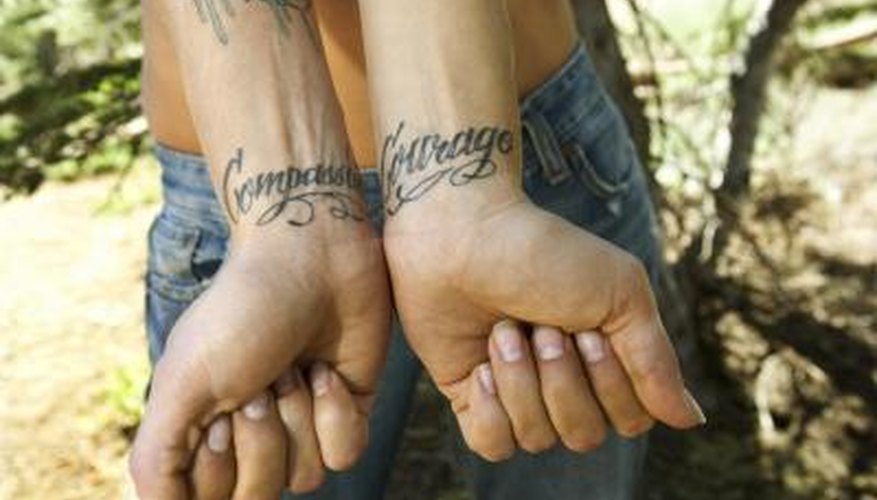Wrist tattoos can go on the inside or outside of your wrist or circle your entire wrist like a bracelet. Properly caring for your tattoo immediately after getting it is essential to minimising some of the risks of tattooing, such as skin infections. Applying antibiotic ointment to the new tattoo, keeping it covered for two weeks and not picking at the scar tissue will allow for proper healing
General Risks
Getting a tattoo anywhere on your body, including on your wrist, comes with certain risks. Your skin might have an allergic reaction to the ink used in tattooing process. Tattooing also comes with a risk of introducing blood-borne diseases such as Hepatitis A, Hepatitis C or HIV to your blood. The best way to protect yourself from these risks is to make certain your tattoo artist uses only sterilised equipment, clean and new needles taken from sealed packaging and wears protective latex gloves.
- Getting a tattoo anywhere on your body, including on your wrist, comes with certain risks.
- Your skin might have an allergic reaction to the ink used in tattooing process.
Specific Risks
Your wrists have significantly less fatty tissue on them than other parts of your body. This means the professional giving you your tattoo will have to be careful of the veins both on your inner and outer wrist. You do not want the tattoo needles to penetrate too deeply into the skin where they can potentially cause damage to or inject ink into the veins. A skilled tattoo professional will have received training to prevent damage to the veins.
- Your wrists have significantly less fatty tissue on them than other parts of your body.
- This means the professional giving you your tattoo will have to be careful of the veins both on your inner and outer wrist.
Pain
Less fatty tissue around your wrist means you will likely experience more pain in getting a wrist tattoo than you would with getting a tattoo on another part of your body. Fatty tissue protects nerve endings and helps to minimise pain. On your wrist your nerves are closer to the skin's surface and therefore feel pain from the tattooing needles more intensely. Of course, pain tolerance is specific to you as an individual.
- Less fatty tissue around your wrist means you will likely experience more pain in getting a wrist tattoo than you would with getting a tattoo on another part of your body.
- Of course, pain tolerance is specific to you as an individual.
Visibility
Before getting your tattoo consider whether you are comfortable with its visibility to others. Wrist tattoos can be more difficult to hide or cover up than other tattoos. Even long shirt sleeves can pull up on the arm, exposing the tattoo to others. This can have implications particularly in professional settings or on job interviews where it is important your tattoo remain covered. The further away the tattoo is from your hand and palm the easier it will be to cover when necessary. Remember you will need to keep the tattoo bandaged for at least two weeks after getting it. The bandaging might also be visible to others.
- Before getting your tattoo consider whether you are comfortable with its visibility to others.
